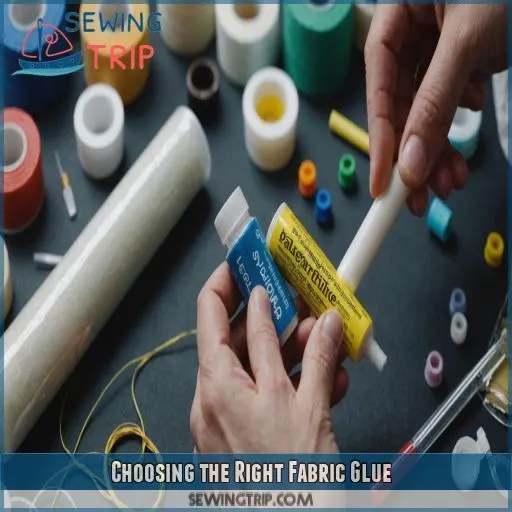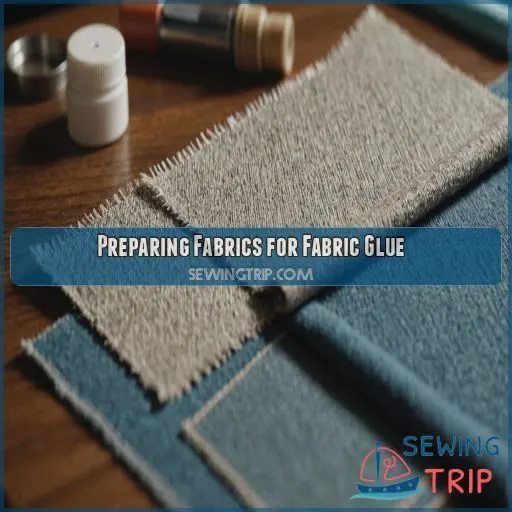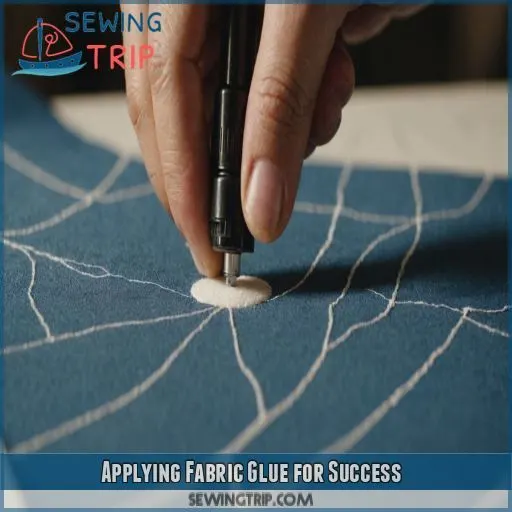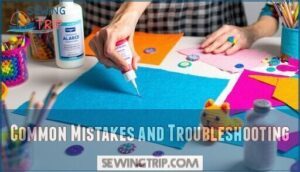This site is supported by our readers. We may earn a commission, at no cost to you, if you purchase through links.
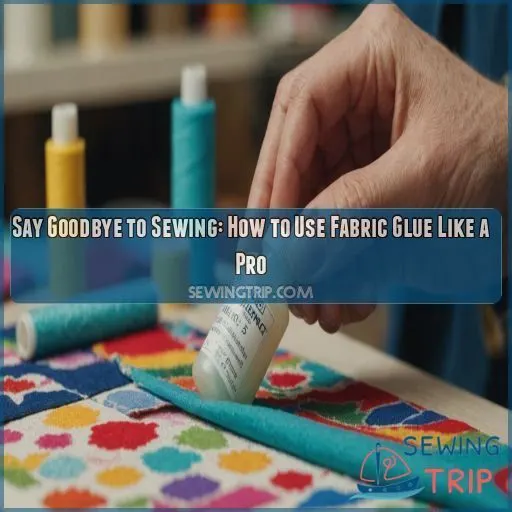 Want to ditch those pesky sewing needles and threads? Mastering fabric glue is your ticket to liberation!
Want to ditch those pesky sewing needles and threads? Mastering fabric glue is your ticket to liberation!
When using fabric glue instead of sewing, you’ll want to start by choosing the right type for your project – think permanent, temporary, or washable.
Next, prep your fabrics by washing, drying, and ironing them.
Then, follow the instructions on your glue bottle, measuring and mixing with care.
Apply the glue evenly, using notches or piping to help with alignment.
Press, clamp, or weight it down for a strong bond.
And, voila! You’ll be on your way to pro-level, no-sew creations.
But, there’s more to it than just slapping on some glue…
Table Of Contents
Key Takeaways
- You’ll want to choose the right fabric glue for your project—think permanent, temporary, or washable—and don’t be afraid to get a little picky about the ingredients, especially if you’ve got allergies or sensitivities.
- Before you start gluing, make sure you prep those fabrics like a pro: pre-wash, pre-dry, and iron them to get rid of any wrinkles or finishes that might mess with the glue.
- When applying the glue, use notches or piping to help with alignment, spread it evenly with a brush or your fingertips (just make sure they’re clean!), and don’t be stingy—use enough glue to get a strong bond, but not so much that it gets all messy and annoying.
- To get a super-strong bond, you’ll want to press, clamp, or weight down your glued fabric—think of it like giving it a big hug—and make sure you let it dry completely before handling it or exposing it to water or heavy use.
Choosing the Right Fabric Glue
You’re about to ditch your sewing machine basics and join the fabric glue fan club – but before you do, you’ve got to choose the right stuff.
, you’ve got to choose the right stuff! With so many types of fabric glue out there, from permanent and temporary to washable and everything in between, picking the perfect one can be overwhelming, but don’t worry, we’ll help you out.
Types of Fabric Glue (permanent, Temporary, Washable)
Ah, the freedom to ditch sewing! With fabric glue, you’re in control. But first, choose the right type. Permanent glue is great for forever bonds, while temporary glue is perfect for testing designs or making alterations. Washable glue is a must for items that’ll get wet or need frequent cleaning. Now, let’s get gluing like a pro!
Fabric Glue Ingredients (latex, Acrylic, Silicone)
Now that you know the types of fabric glue, let’s get down to business – what’s in this stuff? Fabric glue ingredients can be a concern, especially for those with allergies. Latex and acrylic glues are common, but silicone-based glues are a great alternative. Natural options like plant-based adhesives are also available, ensuring a safer, healthier crafting experience.
Suitable Fabrics for Fabric Glue (cotton, Polyester, Blends)
The fun part – choosing the perfect fabric for your glue-up project! You’ve got plenty of options, including natural fibers like cotton, linen, and silk, as well as synthetic friends like polyester and nylon. Fabric blends are also fair game. Just keep in mind that heavier fabrics might need a stronger glue, while stretchy fabrics will love a flexible adhesive.
Factors to Consider (drying Time, Flexibility, Bonding Strength)
Now that you know which fabrics play nice with glue, let’s get down to business.
When choosing a fabric glue, consider the drying time.
Do you need it to set quickly or can you wait?
Also, think about flexibility.
Will your project be subject to stretching?
Consider bonding strength.
How heavy is the fabric?
Finally, think about wash care.
Will it be machine washed or hand washed?
Preparing Fabrics for Fabric Glue
Now that you’ve chosen the right fabric glue, it’s time to get your fabrics ready for a strong and lasting bond – think of it as prepping for a perfect match!
To make sure you have a smooth and successful gluing process, you’ll want to pre-wash, pre-dry, and prep your fabrics with a few simple steps that’ll make all the difference.
Pre-washing and Pre-drying Fabrics
- Pre-wash test a small, inconspicuous area to make sure the fabric won’t change color or texture.
- Wash and dry fabrics according to their care labels.
- Iron fabrics while still slightly damp to remove wrinkles.
- Use a low-heat drying method to prevent shrinkage and damage.
Interfacing and Stabilizing Fabrics
Now that you’ve pre-washed and pre-dried your fabrics, it’s time to give them some extra stability. Interfacing and stabilizing fabrics can make all the difference in getting a professional finish with fabric glue. Think of interfacing like a magic layer that helps fabrics behave and stick together nicely.
| Interfacing Types | Best For |
|---|---|
| Fusible | Delicate or stretchy fabrics |
| Sew-in | Thicker or heavier fabrics |
| Lightweight | Garments that require drape |
| Medium-weight | Home decor or bag-making projects |
| Heavyweight | Upholstery or heavy-duty applications |
Choose the right interfacing for your project, and you’ll be on your way to fabric glue success!
Removing Finishes and Sizing
Freedom from frayed edges and uneven hems is within reach. But first, let’s talk about the not-so-glamorous world of fabric finishes and sizing. These sneaky substances can interfere with fabric glue’s magic. Here’s why you need to remove them:
- Fabric finishes can repel glue, making it hard to bond
- Sizing can leave a residue that weakens the adhesive
- Removing finishes and sizing makes for a strong, lasting bond
Cleaning and Ironing Fabrics Before Gluing
Time to get your fabrics squeaky clean! Before gluing, Before gluing, pre-wash and dry your fabrics to remove any finishes or impurities, just like you would when shrinking synthetic fibers.
. Then, iron them to smooth out wrinkles and creases. Don’t forget to test for stains or discoloration. A clean and ironed fabric is key to a strong bond. Your fabric glue (and your project) will thank you!
Applying Interfacing for Better Adhesion
- Choose a fusible interfacing guide that matches your fabric’s weight and texture.
- Opt for a cotton or cotton-blend interfacing for breathable fabrics
- Use a knit interfacing for stretchy fabrics that need a little extra grip
Applying Fabric Glue for Success
Now that your fabrics are prepped, it’s time to get gluing – and with a few simple tips, you’ll be creating professional-looking bonds in no time. To apply fabric glue like a pro, follow the instructions on the bottle, take your time, and use a few clever tricks to guarantee a smooth, even application.
Following Instructions on Fabric Glue Bottles
The moment of truth – applying fabric glue! Before you start, take a minute to read the fine print on the glue bottle label. It’s like reading a recipe: you gotta follow the instructions to get the desired results.
| Glue Bottle Labels | What to Look For |
|---|---|
| Safety Precautions |
Look for warning signs, like skin irritation or allergic reactions.
Check if it’s best to apply in thin layers or all at once.
Know how long it’ll take for the glue to dry completely.
Find out how to store leftover glue for future projects.
Measuring and Mixing Fabric Glue
Now that you’ve got your fabric glue, it’s time to measure and mix it like a pro! To achieve the perfect Glue Ratio Optimization, consider these tips:
- Use essential measuring tools to get the right amount of glue for your project.
.
- Mix the glue according to the instructions for the perfect Fabric Glue Consistency.
- Start with a small amount to avoid over-applying and wasting glue.
Using Notches and Piping to Help With Alignment
When working with fabric glue, use notches and piping to help you stay on track. Cut small notches in your fabric to create a ‘match point’ for your pieces. For piping, use a ruler or piping foot to make sure you get a straight line. These simple techniques will save you from the frustration of misaligned fabric.
Spreading Glue Evenly (brush, Spreader, Finger Tips)
Now that you’ve got your notches and piping in place, it’s time to get sticky! Spreading glue evenly is an art, but don’t worry, you can master it. Grab a brush, spreader, or even use your fingertips (just make sure they’re clean!) to apply a smooth, consistent layer of glue. This helps create a strong bond and prevents pesky streaks.
Minimizing Glue Mistakes (overflow, Blotches, Stringiness)
Now that you’ve mastered spreading glue evenly, it’s time to tackle those pesky mistakes! To minimize glue mishaps like overflow, blotches, and stringiness:
- Work quickly to avoid drips and runs.
- Apply thin layers to prevent pooling and unevenness.
- Keep a damp cloth handy for quick glue clean-up and to wipe away excess glue before it sets.
Tips and Tricks for a Stronger Bond
Now that you’ve got the basics of fabric glue down, it’s time to take your skills to the next level with some expert tips and tricks for creating a stronger bond that’ll last. By following these simple yet effective techniques, you’ll be able to achieve professional-looking results without ever having to pick up a needle and thread.
Pressing for Better Adhesion
The secret to making fabric glue stick like magic? Pressing for better adhesion! To do this, grab your trusty iron and set the temperature according to your fabric type. For delicate fabrics, sewing with invisible thread use a low heat setting and a short pressing time
, use a low heat setting and a short pressing time. For thicker fabrics, crank up the heat and press for a few seconds longer.
Using Weights or Clamps for Extra Pressure
The secret to a super-strong bond is extra pressure.
Use weights like heavy books, cans, or even a trusty old iron to press down on your glued fabric.
No weights? No worries!
Clamp alternatives like binder clips or even clothespins can do the trick.
Apply even pressure to make sure a rock-solid bond and voila – your fabric’s stuck together like magic!
Allowing Fabric Glue to Dry Completely
Your secret to a strong bond? Patience. Allowing fabric glue to dry completely is important. Here are four pro tips to help you get it right:
- Check the glue’s drying time and plan accordingly
- Make sure good air circulation to prevent moisture buildup
- Control the drying environment: room temperature and moderate humidity levels are ideal
- Resist the temptation to speed up the process – it’s worth the wait
Avoiding Stretching or Pulling While Glue is Wet
When working with fabric glue, you need to let it dry completely without stretching or pulling the fabric. Think of it like waiting for paint to dry – you don’t want to mess up the finish!
| Fabric Weight | Glue Drying Time | Pinning Tips | Support Structure | Gentle Pressure |
|---|---|---|---|---|
| Lightweight | 5-10 minutes | Use thin pins | Use a soft surface | Apply gentle touch |
| Mediumweight | 10-20 minutes | Use medium pins | Use a cardboard base | Apply moderate pressure |
| Heavyweight | 20-30 minutes | Use thick pins | Use a hard surface | Apply firm pressure |
| Stretchy | 10-20 minutes | Use flexible pins | Use a stretchy surface | Apply gentle stretch |
| Delicate | 5-10 minutes | Use thin pins | Use a soft surface | Apply gentle touch |
Be patient, and you’ll be rewarded with a strong, lasting bond!
Using Fabric Tape for Reinforcement
The waiting game – you’ve managed to avoid stretching or pulling your fabric while the glue is wet. Now, let’s bring in the reinforcements! Using fabric tape can be a total game-changer. Here are some tips to get you started:
- Use cotton or polyester tape for seams and hems
- Opt for silk or delicate fabrics like chiffon tape for delicate fabrics.
- Place tape on the wrong side of fabric for a stronger bond
- Apply tape in a straight line, no wrinkles or bubbles
- Press tape firmly to make sure it sticks properly
Common Mistakes and Troubleshooting
Now that you’ve got the basics of fabric glue down, it’s time to tackle those pesky mistakes that can ruin an otherwise great project. From applying too much glue to using the wrong fabric, we’ll walk you through the most common mistakes and how to fix them, so you can get back to creating without a hitch.
Over- or Under-Applying Fabric Glue
The art of gluing like a pro! Now that you’ve mastered the tips and tricks for a stronger bond, it’s time to tackle the pesky problem of over- or under-applying fabric glue.
| Glue Application | Common Issues |
|---|---|
| Too little glue | Weak bond, peeling edges |
| Too much glue | Pooling, excess mess |
| Uneven glue | Blotchy, inconsistent bond |
| Incorrect glue consistency | Inadequate adhesion |
| Insufficient drying time | Weak, fragile bond |
Don’t let glue woes get you down! By finding the sweet spot, you’ll be gluing like a pro in no time.
Using Fabric Glue on Incompatible Fabrics
When you use fabric glue on incompatible fabrics, it’s like trying to force a square peg into a round hole. Don’t try to bond faux fur with a glue meant for cotton, or use a leather-specific glue on silk. Choose the right glue for your fabric, whether it’s stretchy, velvet, or something else entirely.
Not Allowing Glue to Dry Properly
Not allowing glue to dry properly is a rookie mistake we’ve all made. Don’t rush it – let the glue dry completely, following the instructions on the bottle. If it’s drying too fast or slow, adjust your environment or try a different glue. Uneven drying? Try using a fan or a hair dryer on a low setting.
Removing Fabric Glue Mistakes
The inevitable fabric glue mistake! Don’t worry, it’s an easy fix. Here’s how to remove fabric glue mistakes:
- Act fast: The sooner you clean up the mess, the better.
- Scrape off excess: Use a dull knife or credit card to gently scrape off excess glue.
- Use a fabric glue remover: If the glue has dried, try a specialized remover.
- Clean your tools: Wash your brushes and tools to prevent glue stains.
Preventing Fabric Glue From Yellowing or Discoloring
Preventing fabric glue from yellowing or discoloring is a major win. To avoid this rookie mistake, store your fabric glue in a cool, dark place, away from direct sunlight. Choose a reputable brand that’s specifically designed to be colorfast. Always perform a colorfastness test on a scrap piece of fabric before applying glue to your actual project.
Frequently Asked Questions (FAQs)
Can fabric glue be used on delicate fabrics safely ?
You can use fabric glue on delicate fabrics, but choose a gentle formula specifically designed for them (Source). Opt for glues like Aleene’s Original Tacky Glue or Beacon Fabri-Tac, which dry clear and work well with lightweight fabrics .
Are there alternatives to fabric glue for outdoor projects ?
You’re looking for ways to ditch the fabric glue for outdoor projects. Think of it like building a fort – you need strong, weather-resistant "bricks." Consider using waterproof silicone sealant or hot glue instead.
How does fabric glue affect the durability of fabric ?
When you use fabric glue, you’re fundamentally creating a strong bond between fabrics, but it may not be as durable as sewing . However, with the right glue and proper application, you can achieve a long-lasting hold (Source).
Can fabric glue be used on stretchy or elastic fabrics ?
Did you know 80% of crafters struggle with stretchy fabrics? Don’t be one of them! You can use fabric glue on stretchy or elastic fabrics, but choose a flexible adhesive specifically designed for these materials .
Are there eco-friendly alternatives to traditional fabric glue ?
Want to ditch traditional fabric glue for something more eco-friendly? You’re in luck! Consider plant-based adhesives, water-based glues, or even homemade alternatives like flour paste or milk glue . Your planet (and fabrics) will thank you!
Conclusion
The theory that fabric glue is only for amateur crafters is totally debunked.
With the right techniques and a little practice, you can master how to use fabric glue instead of sewing and create stunning, pro-level projects.
By choosing the right glue, prepping your fabrics, and applying it with care, you’ll be ditching those pesky sewing needles in no time.

